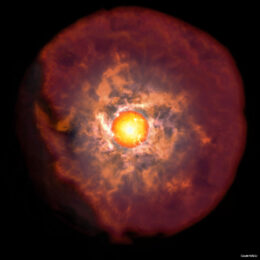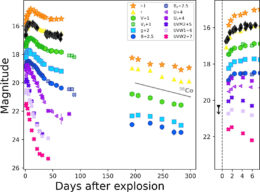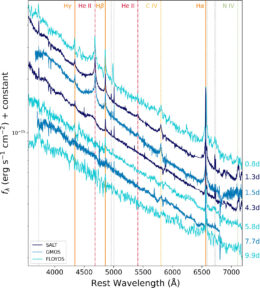If caught just a few days later, SN 2022jox would’ve looked like just another ordinary core-collapse supernova, but early observations set it apart, revealing the gas expelled in the star’s final years.
The Extraordinary Made (More) Ordinary

An illustration of a red supergiant star surrounded by thick circumstellar material. [NAOJ]
These once-elusive early observations give a critical look at what the star was up to before its collapse. Observations suggest that in the final years of their lives, many massive stars lose mass through winds or eruptions. In the first few hours or days after a supernova explosion, the expanding ejecta collides with the material previously lost by the star, creating a burst of short-lived emission lines called a flash spectrum. Once the flash spectrum fades, this crucial information about the star’s immediate surroundings is lost.
Early Observations
In a recent research article, Jennifer Andrews (NSF’s NOIRLab and Gemini Observatory) and collaborators analyzed the flash spectrum and light curve of the supernova SN 2022jox. The event was caught soon after exploding by the Distance Less Than 40 Mpc Survey, which aims to find supernovae in nearby galaxies (within about 130 million light-years) within one day of the explosion reaching Earth.
At just 0.8, 1.3, and 1.5 days after the explosion, spectra of SN 2022jox showed narrow emission lines from hydrogen, helium, carbon, and nitrogen. Using radiative transfer modeling, Andrews’s team found that the gas surrounding the supernova was likely lost by its progenitor star at the rate of a thousandth to a hundredth of a solar mass per year — a high value for a quiescent red supergiant star, but typical for other supernovae with flash features in their spectra.
Critical First Days

Multi-band light curves of SN 2022jox. The right panel shows a zoom-in of the first week of data. Click to enlarge. [Andrews et al. 2024]
Months after SN 2022jox was detected, the authors saw evidence for the expanding supernova interacting with circumstellar gas once again. Taken together, the very early and very late observations of this supernova suggest that it may be common for circumstellar material to be present around “ordinary” supernovae, and observations over a wide time frame are needed to detect these cases.
Citation
“SN 2022jox: An Extraordinarily Ordinary Type II SN with Flash Spectroscopy,” Jennifer E. Andrews et al 2024 ApJ 965 85. doi:10.3847/1538-4357/ad2a49


